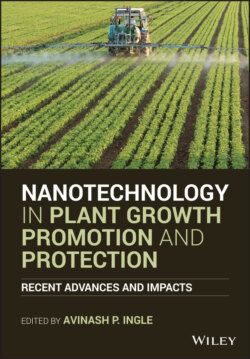Читать книгу Nanotechnology in Plant Growth Promotion and Protection - Группа авторов - Страница 20
1.2.4 Micronutrient Nanofertilizers
ОглавлениеMicronutrient nanofertilizers are those fertilizers which provide micronutrients to the plants (the elements which are needed in small amounts by the plant but are essential for plant growth and metabolism) (Adisa et al. 2019; Zulfiqar et al. 2019). The most important micronutrients are zinc (Zn), boron (B), iron (Fe), manganese (Mn), and copper (Cu). It was reported that cucumber seedlings grown in nutrient solution containing Zn nanoparticles (synthesized from waste tire rubber) showed an increase in shoot and fruit yield as compared with other cucumber seedlings grown in commercial zinc sulphate (ZnSO4) solution (Moghaddasi et al. 2013). Adhikari et al. (2015) reported that maize plants treated with zinc oxide (ZnO) nanoparticles showed increased shoot dry weight and shoot height as compared with untreated plants. Also, Subbaiah et al. (2016) applied ZnO nanoparticles (particle size: 25 nm) as foliar spray on maize which resulted in enhancement of maize growth, yield, and Zn content in the produced grains as compared with maize plants treated with normal ZnSO4. Application of Zn nanofertilizer in pearl millet (Pennisetum americanum) caused significant increase in shoot and root growth, increase in chlorophyll content and leaf protein. Moreover, enhanced crop production as compared with control plants over a period of six weeks was also recorded (Tarafdar et al. 2014). Foliar application of micronutrient nanofertilizers of Zn or B to pomegranate trees resulted in an increase in fruit yield (30%). The magnitude of increase was most pronounced with low concentrations of nanofertilizers (34 mg/ tree for B and 636 mg/ tree for Zn) (Davarpanah et al. 2016). Dimkpa et al. (2017a) showed that micronutrient nanocomposites (ZnO, B2O3, and CuO, at 2.8 mg Zn/kg soil, 0.6 mg B/kg soil and 1.3 mg Cu/kg soil, respectively) when applied to soybean plants under drought stress improved the growth and yield of treated plants as compared with untreated plants.
There are few studies performed demonstrating the foliar spray application of iron oxide nanoparticles, results recorded easy uptake of these nanoparticles and improved growth in different plants such as corn (Li et al. 2016), pumpkin (Zhu et al. 2008), and watermelon (Li et al. 2013; Wang et al. 2013). In addition, some of other studies on the use of iron oxide nanoparticles on crops plants such as wheat (Ghafari and Razmjoo 2013), lettuce (Zahra et al. 2015), soybeans (Alidoust and Isoda 2013; Ghafariyan et al. 2013), clover (Feng et al. 2013), peanut (Rui et al. 2016), rice (Alidoust and Isoda 2014), and Citrus maxima (Hu et al. 2017) showed that Fe nanofertilizer improved several traits of these plants including increased biomass, grain yield, Fe fortification, and improved biochemical parameters such as nutrients uptake, chlorophyll content, and photosynthesis (Raliya et al. 2018). But it should be mentioned that the effect of Fe nanoparticles was relatively concentration‐dependent which implies the need for future studies to adjust the suitable concentrations of Fe nanoparticles and further application to a variety of crops (Zulfiqar et al. 2019).
Foliar application of Mn nanoparticles (0.05 mg/L) to mung bean (Vigna radiata) resulted in improvement of root growth, shoot growth, and biomass as compared to plants treated with MnSO4 (Pradhan et al. 2013). In another study, Dimkpa et al. (2018) showed that application of Mn nanoparticles (6 mg/Kg) did not affect wheat grain yield but enhanced nutrient uptake by the plant. Adhikari et al. (2016) showed that exposure of maize plants to CuO nanoparticles (10 mg/L) resulted in significant increase in growth as compared with untreated plants. Nanocomposites of CuO, ZnO, and B2O3 caused significant increase in the uptake of N, K, Zn, and B in soybean as compared with untreated plants under drought stress (Dimkpa et al. 2017a). Dimkpa et al. (2017a,b, 2019) revealed that root or foliar exposure of soybean or sorghum to the nanocomposites of Cu, Zn, and B or to Zn nanoparticles increase N and K accumulation. These findings indicate the possible role of using nanomicronutrients in fortifying accumulation of macronutrients in plants to achieve better nutrient use efficiency (Adisa et al. 2019).
